



Last changed 13 January 2007
| Model: | Boeing B-29 |
|---|---|
| Serial Number: | 44-86292 |
| Wingspan: | 43 m (141 ft 3 in) |
| Length: | 30.2 m (99 ft) |
| Height: | 9 m (29 ft 7 in) |
| Weight: | 31,400 kg (69,000 lb) empty 54,500 kg (120,000 lb) fully loaded |
| Powerplant: | Four Wright R-3350-41, 2200 hp each |
| Combat Radius: | 4670 km (2900 miles) |
| Service Ceiling: | 9710 m (31,850 feet) |
| Cruise Speed: | 355 km/hr (220 mph) |
| Maximum Speed: | 588 km/hr (365 mph) |
| Bomb Load: | 9090 kg (20,000 lb) |
| Approximate Cost: | $782,000 (1945 dollars) |
The Enola Gay was built under a program code named "Silverplate" to produce B-29 bombers specially modified for atomic bombing missions. The Enola Gay was part of a second batch of fifteen improved Silverplate bombers built between February and June 1945.
The Enola Gay's complete serial number (B-29-45-MO, 45-86292) indicated that it was a B-29 built at the Martin Omaha plant built in block 45, and was ordered in fiscal year 1945. When deployed to the Pacific the Enola Gay was assigned a Victor number, originally No. 12 (or Victor 12), later changed to No. 82 (Victor 82).
The Enola Gay arrived on Tinian on 6 July 1945. Prior to flying the first atomic combat mission the Enola Gay flew eight practice missions from Tinian, then two conventional bombing missions over Japan using the 6300 pound "pumpkin" high explosive bomb, designed to simulate the characteristics of the Fat Man bomb. The Enola Gay bombed Kobe on 24 July and Koriyama on 26 July. On 31 July the Enola Gay carried out a practice drop of the Little Boy weapon, dropping bomb unit L6 which was a complete bomb lacking only the highly enriched uranium to make it active.
One of fifteen "Silverplate" B-29s assigned to the 393rd Bombardment (Very Heavy) Squadron of the 509th Composite Group of the XXI Air Force on Tinian Island, the bomber now know as the Enola Gay was designated simply as No. 82 until 5 August 1945. On that day it was selected as the strike plane for OPERATION CENTERBOARD I, the first atomic attack mission against Japan, by Lt. Col. Paul W. Tibbets, the 509th commander.
Tibbets renamed the plane the Enola Gay after his mother, over the objections of the plane's usual pilot Robert A. Lewis. At 1600 (Tinian time) "Enola Gay" was painted on its nose.
Bomb unit L11 was selected for combat use and on 31 July the U-235 projectile and target were installed along with the four initiators – making Little Boy ready for use the next day. An approaching typhoon required postponing the planned attack of Hiroshima on 1 August. Several days are required for weather to clear, and on 4 August the date was set for two days later. On 5 August Lt. Col. Paul W. Tibbets, the 509th commander, selected B-29 No. 82 for the mission, renamed the Enola Gay after his mother, over the objections of its pilot Robert A. Lewis. Little Boy was loaded on the plane the same day.
At 1400 on 5 August the first combat atomic bomb Little Boy was loaded onto a trailer and taken to the loading pit where a hydraulic lift raised it into the bomb bay of the Enola Gay. At 1530 Parsons began practicing his new task of in-flight propellant insertion. At 1600 Tibbets had his mother’s name, Enola Gay, painted on the strike plane. At 1730 the Enola Gay taxied on to the pad for pre-mission testing.
The preflight briefing for the seven flight crews began at about 2000. The flight briefings for the weather planes occurred at 2300; the strike plane flight briefing was at midnight. At 0015 on 6 August assembly on the flight line began. Just before 0200 the crew boarded the Enola Gayy; takeoff was at 0245.
| The Enola Gay on Tinian Island. |
The Enola Gay rendezvoused with the observation planes over Iwo Jima at 0605. Little Boy was armed at 0730. At 0741 Tibbets began the climb to the drop altitude above 30,000 feet. The Enola Gay came within sight of the Empire, as bombing crews called it, at about 0750 as it approached the southern tip of Shikoku Island.
The weather plane over the primary target radioed good conditions at 0830 and Tibbets announced that Hiroshima would be their destination. At 0909 Hiroshima came into view. At 0913.30 the bombadier, Thomas Ferebee, took control of plane in preparation for release. At 0914.17 the Aioi Bridge appeared in the Norden bombsight cross-hairs and Ferebee initiated the automatic release sequence. At 0915.17 Little Boy dropped away. The fall to the burst altitude of 600 meters lasted 43 seconds, at that moment Little Boy had a vertical velocity of 335 meters/second, just a bit faster than sound.
As soon as the bomb was released Tibbets took control and the Enola Gay began its escape maneuver. Eleven and a half miles from the detonation point and nearly a minute after the explosion the plane was rocked by the shock wave travelling directly out from the fireball, and then several seconds later it was struck by a second weaker shock reflected from the ground. Aside from the sighting of a single fighter, the flight back from the mission was uneventful. The mushroom cloud, which had climbed to 40,000 feet, was visible from the plane for almost an hour and a half, finally being lost from sight at 1041, 363 miles from Hiroshima.
At 1458, after a textbook perfect mission lasting 12 hours and 13 minutes, the Enola Gay landed at Tinian Island.
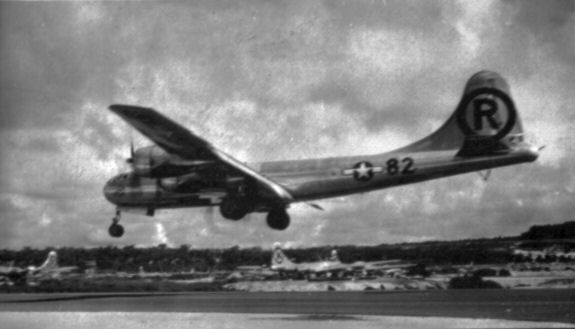 |
| The Enola Gay returning from the bombing mission against Hiroshima. |
The Enola Gay flew one more combat mission, on 9 August 1945 to scout the weather over Kokura Arsenal, the primary target of OPERATION CENTERBOARD II, the second atomic bombing mission.
The Enola Gay was transferred by the U. S. Air Force to the Smithsonian Institution on 4 July 1949. The airplane's last flight ended on 2 December 1952 when it touched down at Andrews Air Force Base, Maryland, where it remained in outdoor "storage", unprotected and unattended, as part of the Smithsonian Institution's collection until July 1961. The Enola Gay was then disassembled and stored indoors at the Paul E. Garber Facility in Suitland, Maryland where it underwent a restoration form 1984 to 1995. The forward fuselage was displayed at the National Air and Space Museum in a controversial exhibit in May 1995 before being moved to its permanent location at the Steven F. Udvar-Hazy Center where its assembly was officially completed on 18 August 2003.
| The Enola Gay at the Steven F. Udvar-Hazy Center of the National Air and Space Museum in Chantilly, Virginia. |
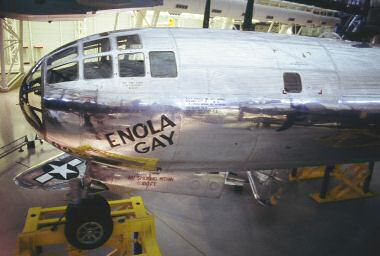 Big image (294 kb) |
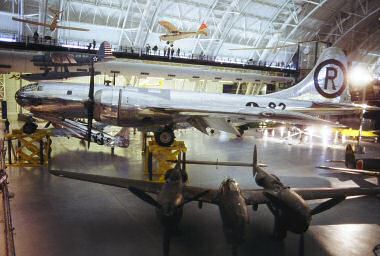 Big image (342 kb) |
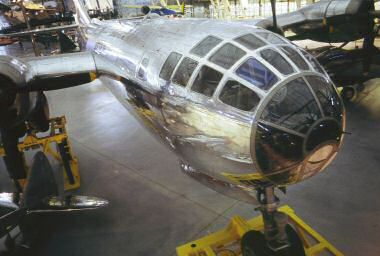 Big image (286 kb) |
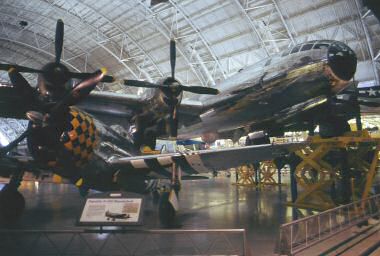 Big image (287 kb) |
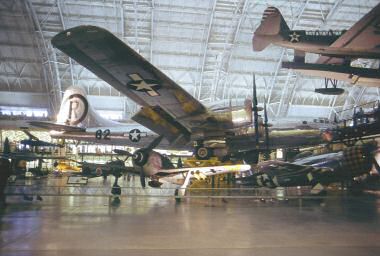 Big image (317 kb) |
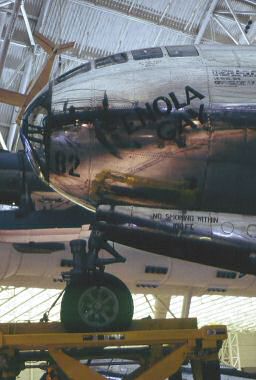 Big image (273 kb) |
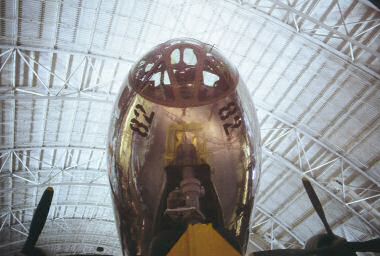 Big image (368 kb) |
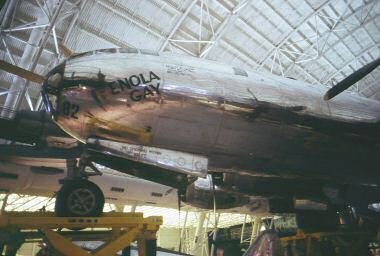 Big image (292 kb) |
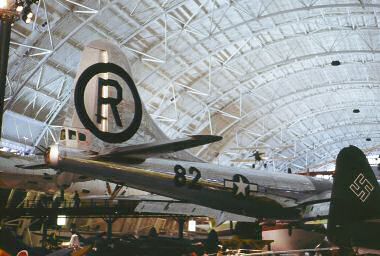 Big image (339 kb) |
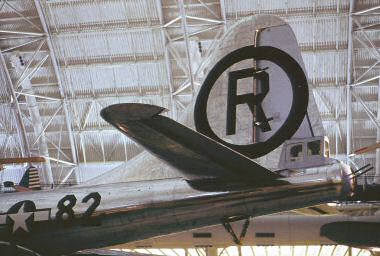 Big image (329 kb) |
| All images above are copyright Mark Sublette. |


